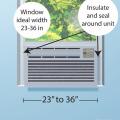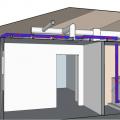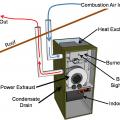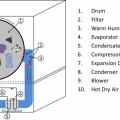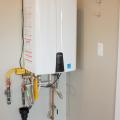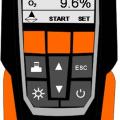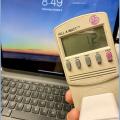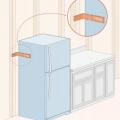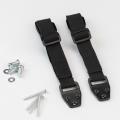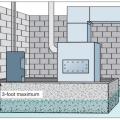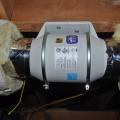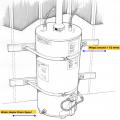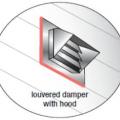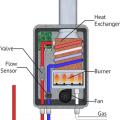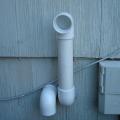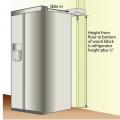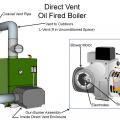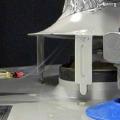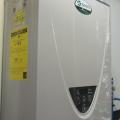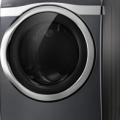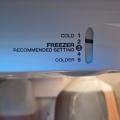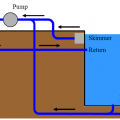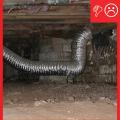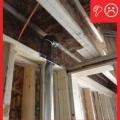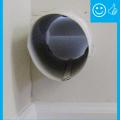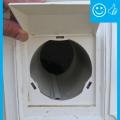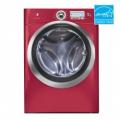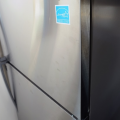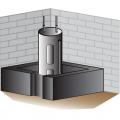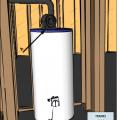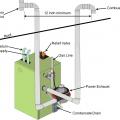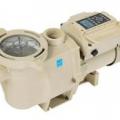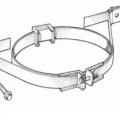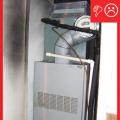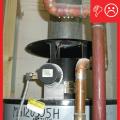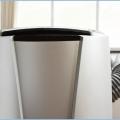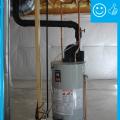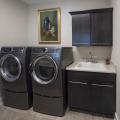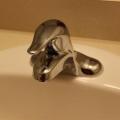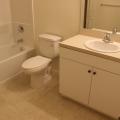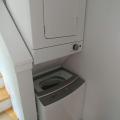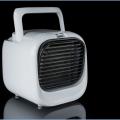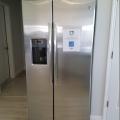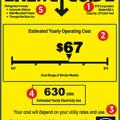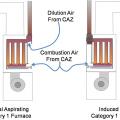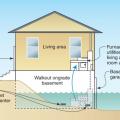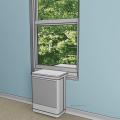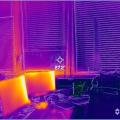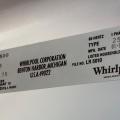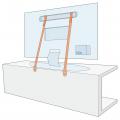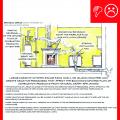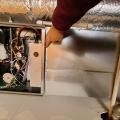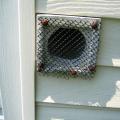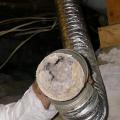Showing results 1 - 91 of 91
A 5,000- 6,000 Btu/hr air conditioner drawing about 500 watts can be installed in one window of a designated cool room (it is important that the installation is insulated and well-sealed
A Corsi-Rosenthal Box is a highly effective DIY air cleaner made of easy to obtain materials such as HVAC filters, a box fan, cardboard, and tape
A direct-vent sealed-combustion fireplace takes its combustion air directly from outside through a dedicated air inlet and vents combustion products directly outside
A direct-vent sealed-combustion furnace has dedicated pipes for combustion air and exhaust
A heat pump clothes dryer is a type of condensing clothes dryer that uses heat pump technology to efficiently dry clothes
A natural gas 94% efficiency tankless hot water heater provides endless hot water.
A portable CO monitor is used to test for ambient CO near a ventless combustion fireplace
A portable power meter shows the power usage of equipment; e.g., this laptop is drawing 12 watts while idle
A refrigerator is secured to the wall by use of an angle bracket with lag bolts, expansion bolts and metal screws
A simple kit for anchoring a TV, appliance, or furniture to a wall may include straps, attachment hardware, and screws for attaching both to the appliance and to the wall
A water heater and furnace are protected from flood waters by a concrete floodwall, with a shielded, gasketed door.
A water heater is anchored to 2 x 4 wood blocking that is attached to the wall studs.
An in-line exhaust fan supplements the ability to exhaust moisture-laden air and lint from a dryer
An indoor water heater should be secured to the wall’s studs to prevent it from moving or tipping over in the event of an earthquake
An innovative U-shaped heat pump offers SEER 15 efficiency and operation with smart phones
At the outlet of the dryer exhaust duct, install a hooded vent with a louvered damper
Basic components of a gas tankless water heater include a high-powered burner, fan, and heat exchanger; condensing gas water heaters also have a secondary heat exchanger and a piped air intake to the sealed combustion chamber
Because flue temperatures are cool, intake and exhaust ducts on a Category 4 direct-vent sealed-combustion condensing furnace can be made of PVC
Because heat pump clothes dryers recycle the hot air in the drum rather than venting it, they use 70% less energy than conventional electric clothes dryers while drying clothes in the same amount of time
Category III oil-fired, sealed-combustion boiler configured as a direct-vented appliance that draws its combustion air from outside
Clothes dryers vented directly to outdoors, except for ventless dryers equipped with a condensate drain
Compare gas tankless water heater efficiencies on the Energy Guide labels or look for the ENERGY STAR label
Cooling setting adjustments on a refrigerator allow the unit to be tuned to meet the target temperature for energy efficiency
Dryer exhaust duct should vent directly to the exterior via a smooth, rigid metal duct
Dryer vent is run vertical with a 90 degree bend and does not vent to the outside
Earthquake-ready home actions include securing cabinets, shelves, and heavy furniture or electronics to walls and preparing utilities for disruptive movement.
ENERGY STAR appliances like the dishwasher and refrigerator save energy and money for consumers.
For fireplaces that are not mechanically drafted or direct-vented to outdoors, total net rated exhaust flow of the two largest exhaust fans is .15 CFM per 100 sq. ft. of occupiable space when at full capacity
Furnaces, boilers, and water heaters located within the home’s pressure boundary are mechanically drafted or direct-vented
Furniture and heavy household items should be anchored to prevent tipping over during an earthquake and for everyday use if small children are in the home
Heavy-gauge metal strapping can be used to secure water heaters and other appliances
Many hardware stores sell appliance bracing kits to secure the water heater to wall framing with metal straps
National Fuel Gas Code (NFPA 2012) identifies four categories for combustion furnaces and water heaters based on combustion type (sealed or unsealed) and vent pipe temperature
Portable air conditioners offer flexibility with where they are located, but usually need to be installed near a window as they require one or two intake/exhaust ducts connected to the exterior
Preventative steps to take throughout the home to prepare for an earthquake or other natural disasters
Right - EPA WaterSense-rated low-flow plumbing fixtures are verified as using less water than typical plumbing fixtures.
Right – a booster fan was installed in this long dryer duct to increase air flow and help prevent the duct from being clogged with lint
Right – An ENERGY STAR washer and heat pump dryer save energy and money for home owners.
Right – EPA WaterSense-rated faucets reduce water usage compared to standard bathroom faucets.
Right – EPA WaterSense-rated low-flow showerheads reduce water and energy usage compared to standard showerheads.
Right – EPA WaterSense-rated showerheads, faucets, and toilets contribute to both water and energy savings.
Right – This net zero energy home has an electric vehicle charging station in the carport.
Right – This stacking ENERGY STAR-labeled washer and dryer save energy and water as well as space.
Small, battery-powered evaporative coolers can be appropriate for personal cooling in arid climates (only)
The cabinet above this refrigerator will keep it from tipping forward during a seismic event
The condensate line (amber-colored plastic tube) from the high-efficiency furnace drains into the sewer via the same drain pipe as the clothes washer
The EnergyGuide label for this refrigerator shows that it is estimated to use 630 kWh/yr (approximately 1.7 kWh per day) based on a standard test procedure
The natural draft and induced draft furnace are both Category I appliances that receive combustion air from the combustion appliance zone
The raised hood at the base of the vent stack on this water heater shows that it is an atmospheric vented gas water heater
The water heater and other appliances are located above the Base Flood Elevation.
This depiction of a saddle installed window heat pump does not obstruct window use and provides fairly quiet 120 Volt operation
This infrared image shows little heat gain from north-facing double-pane windows with blinds, but significant heat output from computer monitors
This larger, less efficient refrigerator shows a listed amperage of 6.5 A, which indicates that it draws 780 watts (6.5 A x 120 V)
This MSHP operates with 120 volts power, has an EER of 18 Btu/Wh, uses about 800 W at full output, and operates remotely with a smart home control system
This wall-mounted high-efficiency condensing gas tankless water heater has PVC vent pipes and insulated water pipes
Use flexible straps to secure large electronics equipment like computer monitors and microwave ovens during seismic events.
Wrong – A clothes dryer that vents to the crawlspace can contribute moisture to the crawlspace; this can result in damp, molding, and rotting insulation
Wrong – Overly powerful kitchen exhaust fans can backdraft other combustion appliances in the home
Wrong – Seams in the furnace-to-AC connection at the air handler are not sealed.
Wrong – the exhaust terminal for a clothes dryer should not be covered with a screen which could trap lint; instead, cover it with a hooded, louvered damper
Wrong – Two combustion appliances are sharing a flue which could lead to backdrafting if one appliance is updated to a direct vent appliance and disconnected from shared chimney.
Wrong –Excessive length and a vertical angle on this dryer duct reduced air flow allowing the dryer duct to become completely clogged with dryer lint

